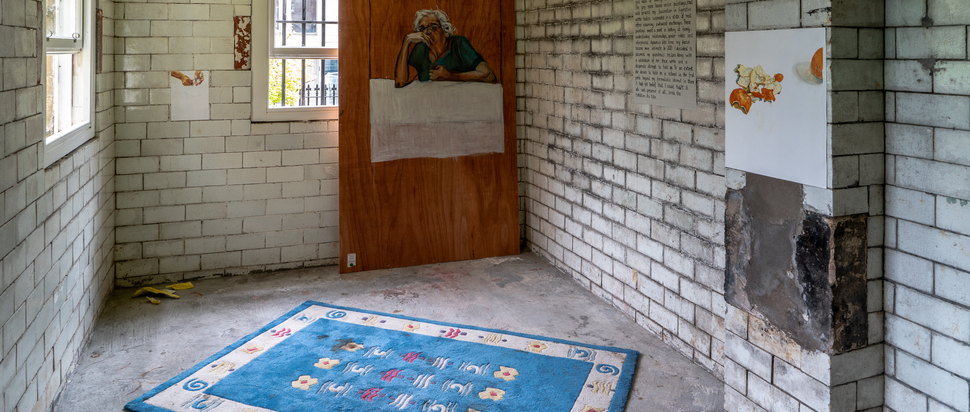Artist Spotlight: Ragini Chawla
Curator and programmer Myriam Mouflih speaks to artist Ragini Chawla on the occasion of her exhibition at the Goethe-Institut, Glasgow
In Ragini Chawla’s recent show at the Goethe-Institut, curated by Ane Lopez, large paintings sit in the outhouse in the garden at the back of the building. A rug is sprawled on the floor, with the phrase “I will have my cake and eat it too” written on the wall. The phrase, a twist on the saying that almost reads as an affirmation, also lends its name to the title of the exhibition. The paintings on show depict people in intimate, domestic settings: a man reclines in a half-sleep; a woman cooking in the kitchen stirs a simmering pot of food – this woman, who I later find out is Chawla’s grandmother, stares out from the painting. Her stern gaze reminds me of a look I have seen on my own grandmother’s face.
Ragini Chawla is an artist who works with painting, sculpture and writing, who graduated from Glasgow School of Art’s MFA Programme in 2020. Speaking with Chawla at her studio at David Dale Gallery, she tells me that her recent paintings have perhaps come from a desire to portray the familial intimacy she experiences with her family in India, after coming back from Glasgow (where she has lived for the last four years). Her family members are portrayed in various stages of rest. Chawla explains: “I think painting over the past year or so has become a lot more intimate for me – I think that’s because when I paint it becomes a very focused thing. Right now, a lot of the paintings are about my family and I think this impulse came from moving to Glasgow; it almost feels like I’ve brought them here and placed them around me. I don’t think I was consciously trying to do that.” Against the cold stone structure of the outhouse, Chawla’s paintings bring warmth and energy to the space, as her family in various states of repose surround the room.
While Chawla’s practice has often focused on figurative painting, it also speaks to a wider urge in her artistic practice to record moments in time and to preserve things that might otherwise be forgotten. There are also recipes among the paintings on show at the Goethe-Institut, which Chawla has been collecting from her grandmother as a way of archiving these familial keepsakes. These works are described in the exhibition text as “a desperate attempt to hold on” and amongst them sit sculptural and painting works that show the remains of meals past – such as a banana peel and the remains of orange peel. A desire to archive sits apart from a habit that Chawla has recently gotten into, of painting on her studio walls, a process that she describes as “painting and then whitewashing over it”. Chawla explains that the appeal of painting on a wall is its possibility, of not being restricted by the size of a canvas.
At her recent publication launch at Good Press, Chawla read a short piece of fiction inspired by a sculpture she had made of an ear in a wall. It is an incredibly evocative piece of writing. She tells me that “Writing becomes a bit more about world-building. Sometimes it helps me to understand what I have made, like a sculpture for example. It allows me to start with an object and then build a story around it.”
Humour is particularly present in Chawla’s work, even in moments where she doesn’t intend it to be. In her writing practice, she makes comics that capture familiar moments of absurdity and subjects that perhaps seem incongruous with the quiet serenity contained within her paintings. In a recent comic, she unpicks human discomfort with animal sexuality through the story of a dog and its owner. Through beautiful illustrations, a fluffy white dog is rendered as a lustful animal. It is funny because it is familiar – a reader can recognise their own discomfort and the humour within that through the comic. “I think I talk about humour so much, and I think about it quite a bit so it’s nice that this translates, even if that wasn’t necessarily my intention – I think that the best the work can do is entertain somebody.” Looking through her illustrations, it is clear that Chawla is drawn to make work about things that could be considered unsavoury or distasteful. A drawing of a man picking his nose is repeated multiple times over one sheet of paper with “pick your nose twice a day” in red letters on top, almost encouraging the act itself. It perhaps doesn’t have the same emotional resonance as Chawla’s warm-hued paintings of her family members or reading her grandmother’s recipes, but it is certainly entertaining.
